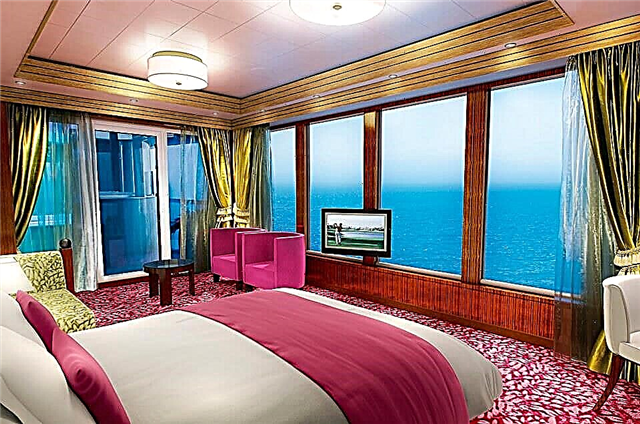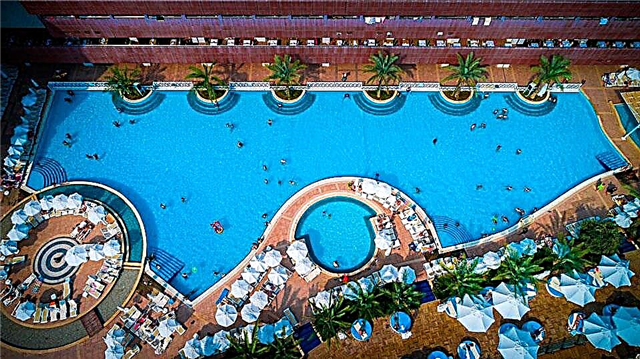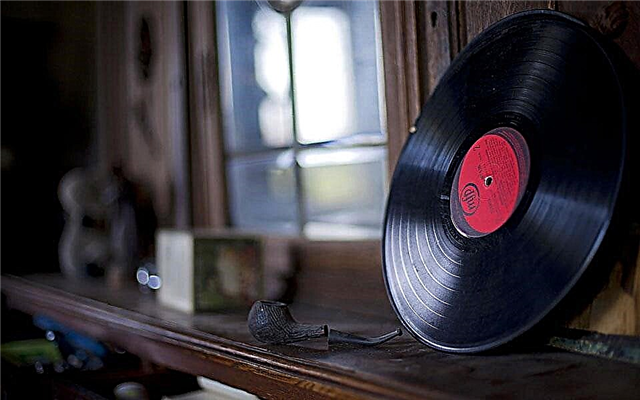Address: Germany, Munich
Start of construction: 1733 year
Completion of construction: 1746 year
Architect: brothers Azam
Coordinates: 48 ° 08'06.5 "N 11 ° 34'10.7" E
Content:
Short description
Munich has long been famous among tourists for its huge number of luxurious cathedrals, temples and small churches. Perhaps no other German city can find so many places where righteous Catholics and Protestants could raise their prayers to God.

Facade of the church
It is worth noting that the overwhelming majority of the majestic temples were erected by order and at the expense of the legendary Wittelsbach dynasty, once ruling in Bavaria. However, not all cathedrals had a connection with the mighty of this world, some were erected by people from the people, who, of course, had certain funds for construction. A striking example of such an architectural structure in Munich, which is not related to the Wittelsbach family, is a church called Azamkirche. To be extremely precise, it should be clarified that its official name is the Church of St. John of Nepomuk.... This temple, which simply puts into a state of stupor with its luxurious facade and rich interior decoration, is rightfully one of the most visited tourist attractions in Munich.
“Why is the church called Azamkirche? Why even guides conducting excursions around Munich only secondarily speak of its official name? ”- such questions can often be heard among Russian-speaking tourists strolling by the beautiful facade of the church dedicated to John of Nepomuk. It turns out that its unofficial, but most often found in guidebooks name, the church received in honor of two brilliant brothers of architects, bearing the surname Azam.

Fragment of the facade of the church
It was these two talented and prudent specialists who were able to erect a stunning church on a small area (22x8 meters), entering which you instantly forget about its true dimensions. It seems to all guests of the city inside the temple that they have entered one of the largest and richest cathedrals in the world. The thing is that the Azams were not only great architects and designers, but also practitioners who knew how to use every centimeter of free space. The rationalism and genius of the brothers, who were educated by their father and at the Roman Academy, can be safely compared with the qualities of the great Antonio Gaudi, who, much later than Cosmas Damian and Aegis Quirin Azamov, showed the world his priceless creations. And, nevertheless, talking about the Azamkirche church in Munich, one should dwell in more detail not only on the history of its construction, luxurious facade and rich interior, but also on the saint, with whom an interesting legend is associated.
The Legend of St. John of Nepomuk
Without exception, all guides, talking about Azamkirch, always mention a story associated with the saint, in whose honor the Azam brothers built a beautiful temple... It should be noted that after his birth in one of the Czech towns, the future saint received the name Jan from his father. Only later, according to the canons of the Catholic Church, he took the name John.

A sculptural exhibition of St. John of Nepomuk and the angels surrounding him above the entrance of the church
Nepomuk was a righteous Catholic who devoted his whole life to serving God and received confessions from his parishioners. It just so happened that the wife of the Czech king Wenceslas IV came to confess to the priest. By the way, this king went down in history as a tyrant who wanted to subjugate not only the will of the people, but also the church. Vaclav suspected his wife of treason and therefore decided to find out about her love affair with John.
As you know, the secret of confession is inviolable, no matter what religion a person belongs to. John of Nepomuk did not succumb to the temptation of Wenceslas, and for this he was thrown into prison with two more Czech priests. After much torture, they decided to execute John: the king ordered to throw the priest into the river from the famous Prague Bridge. According to legend, as soon as the priest drowned, the brightest stars flashed at the place where his body was covered by water. Five stars burned brightly in the water for several minutes and symbolized the crown of John of Nepomuk. After this miracle, the priest in 1729, almost 300 years after his death, was ranked among the saints: in many icons he is depicted with a crown consisting of five bright stars. By the way, on the Prague Bridge to this day you can easily find the place where Saint John of Nepomuk was deprived of his life: where the priest was thrown into the water, who kept his oath to God, there is a cross and two nails cast from copper.

Church ceiling with scenes from the life of St. John of Nepomuk
Subsequently, the body of the innocently murdered priest was removed from the river and buried in one of the cathedrals. The saint was revered everywhere, and Bavaria was no exception, where the Azam brothers erected a beautiful baroque church in his honor - Azamkirche or the Church of St. John of Nepomuk.
Azamkirche Church - construction history
In 1729, one of the two brilliant brothers of architects bought a house in Munich. He was lucky, and after a short time Azam managed to buy three more buildings. On the acquired territory, on Sendlingergasse Street, the brothers decided to erect three masterpieces at once: the first of them is the Azam family estate, the second is the priest's house and the third is the Church of St. John of Nepomuk. If you look closely at the above, it will become clear that it was in this year that John of Nepomuk was numbered among the saints.
The project was developed in record time, and all work was completed by 1745. The brothers were brilliant in everything: one of them was an architect and artist, and the second was an artist and a sculptor, famous throughout the Old World.

Church interior
Their works were highly valued, and one could see the unique works of the Azam brothers far beyond the borders of Bavaria: paintings, sculptures, stucco moldings were appreciated not only by the rich people of Europe, but also by monarchs. Naturally, the Azamkirche church, which the brothers decided to make private property, made an indelible impression on the inhabitants of Munich... Surprisingly, the townspeople, amazed by the luxury of the temple, began to simply demand that the brothers make the church public. By the way, the brothers listened to the opinion of the people, and already in 1746 the church became available to everyone without exception.
Azamkirche Church - the creation of geniuses
“Already on the way to the building itself, you begin to understand that you are not dealing with an ordinary church, but with something that was built with the blessing of higher powers!”, - once said in an interview with the church an enthusiastic guest of Munich, who, by the way, he turned out to be a reputable architect from the United States. At the bottom of the entrance, you can see rough stone, which gives the impression that the small church of Azamkirche is of natural origin. Above the entrance is a beautifully executed sculpture of St. John of Nepomuk surrounded by angels. Naturally, above his head, you can see the crown of the very five bright stars that shone in the waters of the Vltava River.

Many tourists, having enjoyed the sculptures and the stunning entrance, rush to enter the temple as soon as possible, the interior decoration of which in many avenues is described in only three words: "the richest", "luxurious", "magnificent". However, do not rush, as the guides advise, you should carefully examine the huge window, which is located immediately behind the sculptures of St. John of Nepomuk and the angels.It is from this window that we can conclude that the Azam brothers were distinguished by their practicality: with the help of it they solved the problem of natural illumination of the temple, which is small in size, and even located between two buildings. One of the buildings is known to be the family home of the Azam family.
Due to the fact that the brothers built a church for their family and could afford not to adhere to any requirements from the customers, they made the interior of the Azamkirche look like a palace interior... Everything shimmers with gold: the magnificent painting, sculptures, the majestic altar resemble, rather, the residence of the monarch, rather than the interior of the temple. Such splendor symbolizes the love of two geniuses for God, for his heavenly kingdom. The Azams never hid the fact that they decided to build the Church of St. John of Nepomuk in order to save their souls.

The small two-story Azamkirche church in Munich is beautifully lit. The architects' solution, thanks to which it was possible to achieve indirect lighting of the choirs, evokes admiration. The cornice, which crowns the choir, "hangs" right in the air! Naturally, this is just an illusion, but what an illusion! The backlit figure of the Trinity evokes a sense of awe and the light seems to have an unnatural origin.
As is known from the surviving documents, most of the funds for the construction of the Church of John of Nepomuk were allocated by Egid Azam, who developed its project. But the painting and most of the canvases and sculptures were made by his brother Kosma Azam. In the Azamkirche church, despite its small area, you can spend the whole day admiring the unique stucco, frescoes, paintings and sculptures... But the main thing that captures the spirit of any visitor to Munich who visits the Azamkirche for the first time is the majestic altar. It is made in the depths of the nave and can be called two-level. This altar is dedicated to the revered Saint John of Nepomuk in Europe.
On the upper level, there is a small, golden-colored window. It, as conceived by the architects, symbolizes the sun, and the light that pours through it gives the whole room an atmosphere of mysticism. The main element in the altar of the Azamkirche Church is the Throne of Mercy. On this throne, you can see the Creator, who in his arms holds the Savior of all mankind, crucified on the cross.

This altar introduces with its magnificence and attentive attitude of artists even to the smallest details, into a mute shock of even the most inveterate skeptic. In the central part of the altar of the Church of St. John of Nepomuk there is a piece of the relics of the Saint.
Considering the grandeur of the interior decoration, one can also see the symbolism characteristic of the Azam brothers. The room, whose high ceiling seems to recede into the sky itself, is painted in different colors. In the place where the benches for the parishioners are located, everything is done in dark colors, a little higher, the color gradually becomes saturated blue, which symbolizes the power of the monarchs, but the ceiling is the lightest part of the building, which symbolizes the power of God. In order to create this effect, the architects designed windows at the very top of the temple, from which natural light floods the "kingdom of the Lord". In addition, on the ceiling of the Azamkirche church, you can see scenes from the life of the martyr, canonized, John of Nepomuk.
Azamkirche is a Catholic church, but it was not built according to its canons, which more than once aroused the discontent of the clergy. But, it is worth recalling that the temple was originally built as a private property, which means that the Azam brothers had the right to build and paint it at their own discretion. For example, Azamkirche is located with a facade to the west, and, as you know, all Catholic churches are usually oriented to the east. Secondly, the cross on which the Savior of mankind is crucified hangs lower than the rules for Catholic churches require.

Altar view
Despite all these disagreements with generally accepted canons, the Azamkirche, like the Church of St. Peter, is considered the most popular among the residents of Munich. Services are held in it to this day, and every Catholic can raise their prayers to God in the church. Tourists should remember that viewing the Azamkirche in Munich is possible only at a time when services are not held there.... The rights of Catholics who live in Munich should be respected strictly, because as mentioned above, the church was built as a symbol of love for God and was given to the people. The parishioners' benches are always full, and this is not at all about the popularity of this temple among tourists and its convenient location. Luxury that is dedicated to God is not, in the opinion of Catholics, repulsive. The asceticism inherent in the Frauenkirche in Munich is now out of fashion, it is much more pleasant to offer your prayers to God in a place where every detail of the interior and the luxurious altar is thought out to the smallest detail and richly decorated.











